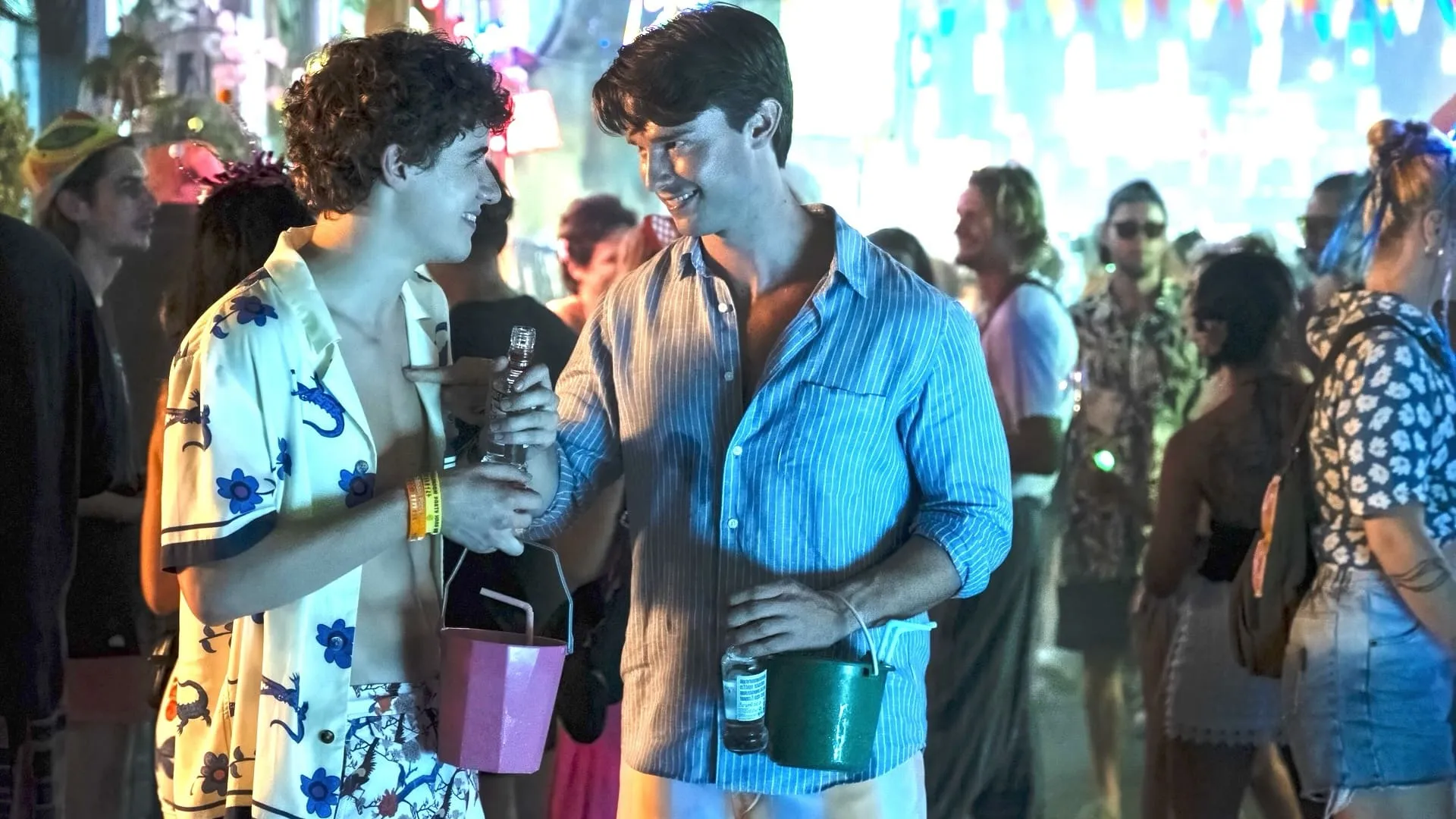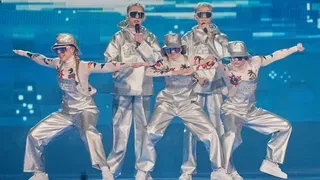
Apr 23
Choreographer Matthew Rushing Pays Tribute to Alvin Ailey with 'Sacred Songs'
Robert Nesti READ TIME: 10 MIN.
When Matthew Rushing was around 12 or 13 years old, he recalls getting a ticket to see The Alvin Ailey American Dance Theater in Los Angeles where he grew up. "I was seated in the front row by myself, and I remember seeing two ballets." One was "Cry," choreographed by Ailey for the late Judith Jamison; and the second was "Revelations," Ailey's iconic ballet that looks at the African-American experience through the prisms of spirituals. "I had recently been baptized," Rushing recalls, "so that was one of the indelible moments sitting in a theater and watching a performance that articulated an experience I just had. It was affirming. It opened my eyes to what dance can do and what dance can be. And that's when I decided I wanted to be a dancer."
Rushing joined the Ailey company in 1992, after having trained at The Ailey School as a scholarship student and was part of Ailey II, the company's junior ensemble. Over the years he has grown with the company: becoming the company's Rehearsal Director & Guest Artist in 2020. In 2020, he was appointed Associate Artistic Director and in 2023, he became its Interim Artistic Director. In addition, he has choreographed numerous works, which include "Sacred Songs," a work inspired by the company's iconic "Revelations," the Ailey ballet that remains the cornerstone of the company's repertoire.
Watch a preview of the Alvin Ailey American Dance Theater's current tour.
Rushing took on the task of revisiting "Revelations at the time of its 60th anniversary." It began when he discovered in Jennifer Dunning's biography of Ailey that the ballet was originally slightly more than an hour long when it premiered in 1960 at New York's 92nd Street Y. A year later, Ailey shortened it by a half, but there is scarcely a record of it in this original form. But Rushing saw that Dunning published a photo of the original program that listed the songs, those that are still part of the work and those taken out. This led Rushing to want to create a ballet comprised of the songs that were removed to celebrate "Revelations." He employed the assistance of composer and creative associate Du'Bois A'Keen in creating the modern soundscape for the piece and premiered the piece in December 2024 during the Alvin Ailey American Dance Theater's season at New York City Center. The performance was part of the "Edges of Ailey" exhibition at the Whitney Museum, which explored Ailey's life, work, and legacy. The score was released on streaming platforms earlier this year under the title "Sacred Songs Suite."
The work is currently part of the Ailey company's annual tour that comes to Boston Boch Wang Center Thursday, April 23 to Sunday, April 25 sponsored by the Celebrity Series of Boston. In addition to "Sacred Songs," which will be performed on Saturday (2pm) and Sunday (3pm) are regional premieres of new works by former Ailey company members: Hope Boykin and Jamar Roberts, along with a new piece from legendary contemporary choreographer Lar Lubovitch, and a new 25th anniversary production of an enduring classic by Ronald K. Brown.
For more details about the Boston engagement, follow this link. For more information about the Alvin Ailey Dance Company and its current tour, visit the company's website.
EDGE recently spoke to Rushing about "Sacred Songs," its relationship to "Revelations," and what's he sees in the future for the company.
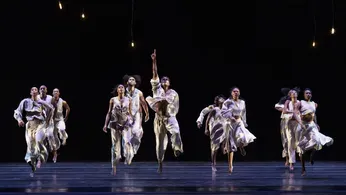
Source: Paul Kolnik
EDGE: You have your ballet "Sacred Songs" as part of the program this year. This is a work created from what was originally part of "Revelations" when it first premiered in 1960?
Matthew Rushing: Yes, correct. It was first premiere the 92nd Street Y and was close to an hour long. He later condensed it and took out maybe half the songs.
EDGE: Why did he do that?
Matthew Rushing: During the premiere, it was performed with live musicians. I'm not sure if it was a choral group, but it definitely did have live singers on stage. And at that moment, the company could not tour live musicians. Additionally, on tour, there are usually three different pieces of comparable length, usually 20 – 30 minutes apiece. So that's probably one of the reasons why Mr. Ailey condensed it.
EDGE: You first heard about the ballet when you were reading a biography of Alvin Ailey?
Matthew Rushing: In the biography by Jennifer Dunning. It was in a chapter on "Revelations," in which she was writing about the premiere and all the work that went into it. And in the book, there was a picture of the program for the premiere that listed the songs, those that are still part of the work and those that were taken out.
EDGE: And you worked with musician Du'Bois A'Keen on the mix of the songs?
Matthew Rushing: Yes. He's he creative collaborator of the piece because he is more than just a musical director. We would sit and brainstorm and talk about how we could reimagine the spirituals in different genres so they can not only speak to the current generation, but also speak to the future generation. And the way we thought of doing that is to make this music have a specific and modern sound. The spiritual has a very operatic sound and soulful, but to that we would add different ideas, such as have an electric guitar solo in "Precious Lord." We played with different ideas musically. And he helped me with the structure of the ballet. There were certain songs that we felt that were too long, so we actually only used the chorus. Sometimes we only used one, one line from the from a song, and didn't use the entire song. So this was an extremely creative, inspirational process.
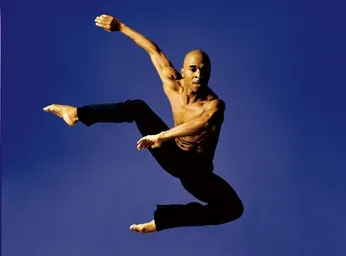
Source: Andrew Eccles
EDGE: Do you consider the piece to be a contemporary extension of "Revelations?"
Matthew Rushing: No, like I often tell people, it's not a prequel, it's not a sequel; it's a piece that pays tribute to "Revelations." I like to say it's a piece that continues the conversation of "Revelations." When I say that I mean it continues the conversation of the importance of the spiritual, the importance of sharing the experience of the African American culture in the Black church. And so I just wanted to continue the conversation by honoring "Revelations" with "Sacred Songs."
EDGE: I think you have said the spirituals are building blocks of life, and they feed into our faith and hope. Can you kind of talk about the meaning of spirituals in people's lives?
Matthew Rushing: As I entered in the process, I wanted to find out what were the building blocks of spirituals. And through the research, I came across some reoccurring themes. Lament is one of those. Others are faith, and hope and joy. These are things that repeatedly came up in different readings, and as I thought about them, and even had conversations with the dancers about them, it really proved that not only were these very clear themes of the spiritual, but they're themes of humanity. And I think that's one of the things that makes "Revelations" so universal is that even though it is articulated through the experience of the African American culture, it speaks on our shared humanity. Everybody experiences lament. Everybody strongly believes in something we call that faith. And everybody, I would say gravitates or wants to embrace hope and joy in their life. So, yeah, so that's what I would call the building blocks of the spiritual.
EDGE: I think you said that you wanted initially to create a completely distinct work, but Alvin Ailey kept pulling you back to his work...
Matthew Rushing: At first, I didn't want to choreograph or create any movements that would directly relate to "Revelations." I really wanted to separate myself from that. But as I was choreographing, I couldn't resist and things came up, such as the reaching of the arms that's very popular from "Revelations." Another thing that was I felt I gravitated towards was using the different genres of modern dance mixed with traditional dance mixed with modern dance. It was something I just also gravitated towards, and I think it had a lot to do with me being a part of the Ailey company for so long and being an admirer of Mr. Ailey's choreography. It was kind of like part of my DNA. So as I tried to my best to kind of give a unique perspective, I kept on going back to what was in my blood, and that was a lot of the ideas and sensations and movements of Mr. Ailey's work.
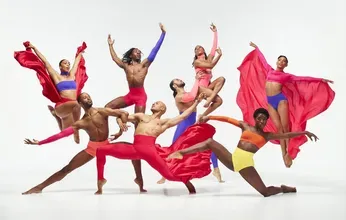
EDGE: How does Alvin Ailey spirit live on in the company?
Matthew Rushing: Through his ballets, through the people who worked with him, those who worked underneath him, as they share stories, as they share his standard of excellence. As when you're coached by someone like Sylvia Waters, who help found the Alvin Ailey Repertory Ensemble, now known as Ailey II, that she led for nearly 40 years. She actually danced in "Wade in the Water" while Mr. Ailey was in the company. Or being coached by Masazumi Chaya, who was a former Associate Artistic Director, who was Mr. Ailey's right hand, who tells stories of what Mr. Ailey was thinking of when he choreographed these ballets. Or hearing other former members who were in the company with Mr. Ailey talk of their experiences and having them coach you in the movement taught them by Mr. Ailey. Those are ways his spirit remains alive.
EDGE: As interim director, where do you see the company going?
Matthew Rushing: Where do I see the company going? I feel, though it may sound like a general answer, it's true. Forward with continual growth and continual expansion that will look different from year to year, depending upon the vision of the director at the time. But the idea is always to move forward, but with a very clear grasp of where we came from. So we're always rooted as we grow, and we never lose sight of the founding vision that Mr. Ailey started. I feel like it's captured in his mantra that says dance came from the people and should be delivered back to the people. As we move forward, we just stay true to that and try to be as creative as we possibly can. It is how we articulate that. And it's also important to move forward with the direction that dance is going, and remain relevant, but also holding true to our traditions.
EDGE: "Sacred Songs" has a great score. How did come to record it?
Matthew Rushing: We had a two-week residency at the 92nd Street Y, which was really amazing, because revelations was premiered at the 92nd Street Y. So as we returned there, as we had our residency, and were in the same space that it was actually created. The residency was just with me and the musicians, and as we were putting together the music and playing with different genres, we felt immediately that there was something special about it, whether it was a result of someone just bursting out in tears as they heard a song, or just feeling the perfect balance of history – the past and present and future all wrapped up in melody. It's hard to articulate, but it's extremely easy to feel. And that's when we knew this music is special, and would benefit from recording it and making it public.
EDGE: You dedicate "Trouble Traveling" to your mom who passed when you were creating the piece. Can you talk a little bit about the process of grief and how that helped you?
Matthew Rushing: It's still helping me. Honestly. I was in the middle of creating the piece and I couldn't stop to properly grieve. I had to continue working. One of the ways I thought would help me is to dedicate a section to her. "Troubles With the World" was one of the songs taken out of "Revelations" and as I first started to listen to it, I immediately thought of my mother. My mother was ill at the time, and I just had a thought, a passing thought, that I would love to create a piece to this song in tribute to my mother. And then when she passed, I felt like it was more than a coincidence that I had that thought, so I pursued the idea of creating that one section, and as I finished it, I knew that this would be a tool for my grieving. So each time I watch it on tour, I have a different response. Sometimes I'm in tears from joy, and sometimes I'm literally in tears from grieving, and sometimes I'm just joyfully thinking about her. It has turned out to be a huge gift that I could and can continue to grieve through the piece.
For more details about the Boston engagement, follow this link. For more information about the Alvin Ailey Dance Company and its current tour, visit the company's website.
Robert Nesti can be reached at [email protected].
